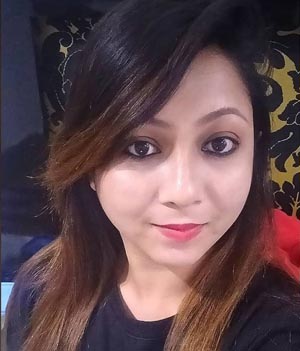Swapna Mangar
This edition of the Power Women series takes us across the globe to India, where Swapna Mangar is currently working for TE Connectivity. Unlike all of the other female engineers featured in the series, Swapna has not lived in the United States nor has she traveled to the US. However, she has worked for US-based companies in India. The article will provide some insight as to the similarities and differences between the educational and career paths of students in the two, distant countries.

Swapna was born to a Nepali family in Siliguri, India. Her father was a government employee of the school system, where he was a lab attendant and arranged experiments. Her mother was a homemaker. Although her father had no formal engineering education, Swapna’s childhood was filled with memories of her helping her father to repair mechanical and electrical systems. She was always intrigued by how items functioned. Because the geographic area in which she was born was very conservative, women were seldom engineers. Swapna’s mother suggested that she pursue a government job such as teaching. On the other hand, Swapna’s father encouraged her to become an engineer due to her interest in science.
In 6th grade, Swapna took her first STEM-related class during her time at Kendriya Vidyalaya Sevoke Road in Siliguri, India. Subsequently, she continued to follow the science path during high school, enrolling in classes like physics, chemistry, math, and computer science. After high school, Swapna took a college entry test and scored within the top 10%. Because she was so proficient in science and math, she decided to attend college for engineering. She chose a public university in southern India, Annamalai University, though she was from a northern Indian town. Like in the United States, there are both public and private schools in India (with a significant different in tuition fees). She majored in Electronics and Communication. She said that she had to convince her parents to allow her to travel so many kilometers across the country, as it was so uncommon for females in her hometown to not only pursue engineering but also to veer such a distance from home. After a little swaying, her parents were very supportive. I questioned Swapna about her coursework because it is less common for an electrical/electronics engineering degree to be combined with a communications major in the United States. She confirmed that her program did include all of the technical classes and also had a large amount of coursework in communications.
Her classes were comprised of about 70% males. She mentioned that there were a few situations in which she was subjected to traditional thinking—that women should be at home or in traditional female jobs while men were more prominent in the technical workforce. However, such situations were counter-balanced by a few professors who always encouraged the females and treated them with the equivalent respect as the males.
After graduation, Swapna was hired by Automotive Axles Ltd. as a graduate engineering trainee. She was promoted to Senior Engineer, spending a total of 3 years there. As she strived for growth potential, she then decided to work for Honeywell Aerospace as a project analyst for 2 years. Due to personal reasons and wanting to care for her parents, she left Honeywell to return to her hometown. During her 6 months of unemployment while supporting her family, she furthered her education by taking a PMP Certification class. This class was heavily focused on project management, an area of interest to her. Once she re-joined the workforce, she returned to the Banglor province in the south, and was hired by TE. She has since held several roles at TE. Her first assignment was as a project analyst responsible for schedule management, cost management, expense reporting, risk management, program execution, and stakeholder management. Now, she is a project manager working with PBL (private brand labelling) projects. She explores new opportunities and markets, acquires new business, launches products, and prepares business cases while still managing corporate risks and being responsible for the successful management of a program. She is currently working in program management on cable glands and terminal blocks.
In terms of obstacles, Swapna admits to having some struggles in her earlier career. She remembers supervising 5 employees in one of her roles. One of the senior-level male employees was resistant to taking direction from a younger, female boss. After some time, Swapna’s expertise and work performance gained her his respect and he began to follow her instructions. In other instances, she was paired with male counterparts on assignments when she was very capable of completing the tasks independently. In her current role, however, she is regarded as equally as her male counterparts.
Swapna advises students to consider engineering as a career if they are curious and have an interest in the ever-changing technological developments of society. With all of the emphasis on gender diversity, she believes there is so much opportunity for females in entry level roles as well as in leadership. There is also significant learning opportunity. Further, engineers drive innovation and gain exposure as they present their projects to upper management and customers. She encourages students to learn the concepts and learn them well—become expert in an area or two. To do so, they shan’t be afraid to ‘get their hands dirty’.
Outside of the standard work day, Swapna takes part in a PMI team to encourage other females in industry. She also is involved in the TE Women in Networking group, which hosts female events and is attended by various levels of management at TE. Female leaders provide support to the newer members, often discussing their own personal challenges and work/life balance concerns.
Thank you, Swapna, for sharing your story and best wishes for future successes.
If you are interested in sharing the stories but missed the original WHN distribution, the articles are available on the Jana Diversity Solutions web- site at www.janadiversity.com, or at wiringharnessnews.com.
If you know a female engineer who would make a great candidate to feature in the Power Women series, please direct them to me at melissa. [email protected]






























































